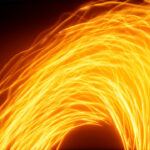This is something I do to help reduce eye strain in certain situations, the main culprit on this for me is whenever I have to do a lot of clipping paths in Photoshop; the task itself requires a bit of staring and concentration which, combined with a bright screen, can really hurt your eyes after a while.
This is not helped by the UI in Photoshop which, on CS5.5 and below is quite a light grey (Adobe have changed this to dark grey in CS6 which is much easier on the eyes), but even without the UI colour the images you’re working on themselves may be quite high-key; so what can you do to help your eyes out?
Two things basically; eco-mode and adjustment layers, let’s go over them in that order:
Eco-mode:
Now this one depends on your monitor and what features it has, a lot of new monitors have an ‘eco-mode’ button that you can press to go into a low power consumption mode, for example my main monitor switches between 65%, 35% and 20% reduction. The good thing about this is that the lower the power, the dimmer the screen – an utterly useless feature most of the time as far as a designer is concerned, but in this very particular instance it is a great way of reducing eye strain when necessary.
Adjustment layers:
The adjustment layers in Photoshop are a great way of making non-destructive colour corrections and, well, adjustments to your images; they are also pretty good at helping your eyes out. Ok, so first off there’s the obvious one of filling a layer with black and knocking the opacity down to 50% or something to get a pretty good start at reducing eye strain; but say the image you’re working on isn’t on a high-key background and, instead, the strain on your eyes is from trying to pick out the cleanest line through loads of background clutter? Well in that case using adjustment layers to make the pertinent bits of your image stand out is a quick and easy way to go; black and white, invert and levels are the ones I tend to use. The first two don’t need any explanation but with levels I just crush the colours using the input sliders and it can really help clear up where the edges are in your image; I used this recently when I was doing a load of clipping paths for leaves I’d photographed to use on custom CG trees and it really helped get precise edges.
Obviously this all depends on your image and it might not work out all the time, but for the seconds it takes to try it might be worth it – your eyes will thank you for it in the long run.
CT






